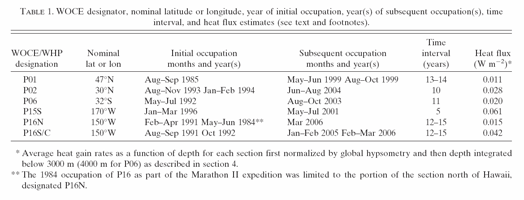
High-quality temperature (T), salinity (S), and pressure (P) data collected in the Pacific Ocean using conductivity–temperature–depth (CTD) instruments during hydrographic stations occupied first as part of the World Ocean Circulation Experiment (WOCE) Hydrographic Program (WHP) in the 1980s and 1990s, and more recently in support of Climate Variability and Predictability (CLIVAR) and CO2 programs are analyzed here (Fig. 1 and Table 1). Data from sections nominally along 47°N, 30°N, and 32°S are reanalyzed, but in a slightly different manner than in Fukasawa et al. (2004) and Kawano et al. (2006b). In addition, new analyses are presented from sections along 150°W in both hemispheres and 170°W in the Southern Hemisphere. The carefully calibrated CTD data from all these sections are thought to be accurate to at least 0.002°C or better in temperature, and 0.003 PSS-78 in salinity (which is reported on the 1978 Practical Salinity Scale). At most stations, data were collected from near the ocean surface to within about 10 m of the ocean bottom. The initial sections were occupied from 1984 to 1996, and the more recent occupations were made from 1999 to 2006 (Table 1).
Station spacing is important for resolving the signals analyzed here, but is difficult to summarize in a tabular form and so is discussed here. The first occupation of WOCE section P01 (Talley et al. 1991), a primarily zonal section nominally along 47°N, had station spacing near 85 km, and as for all sections analyzed here, station spacing was closer over rapidly changing bathymetry. Thus for P01, closer stations are found near the eastern and western ends of the basin, as well as the crossing of the Emperor Seamount Chain near 170°E. The second occupation of P01 (Fukasawa et al. 2004) had similar station spacing.
The first occupation of WOCE section P02 (more information is available online at http://cchdo.ucsd.edu), a primarily zonal section nominally along 30°N, was a 3-ship operation extending over 2 calendar years with combined interior station spacing at distances of 56 and 88 km, with a few intervals around 250 km. The U.S. CLIVAR/CO2 reoccupation of this section had station spacing mostly at distances of 56 and 73 km, with a few 110-km intervals.
The first occupation of WOCE section P06 (Tsimplis et al. 1998), a primarily zonal section nominally along 32°S, had interior station spacing at distances of 48, 63, and 78 km, with a few short sections around 94 km. The reoccupation (Kawano et al. 2006b), done as part of the Japanese Blue Earth Global Expedition (BEAGLE) 2003, had station spacing like the original.
The first occupation of the Southern Hemisphere portion of WOCE section P15 (McTaggart and Johnson 1997), a primarily meridional section occupied nominally along longitude 170°W known as P15S, had interior station spacing (67°–5°S) of generally 56 km; it increased to 111 km from 5°S to the equator. The second occupation (more information is available online at http://www.marine.csiro.au/nationalfacility/franklin/plans/2001/fr0501s.html) was made along the same track from 49.5°S to the equator as part of the Australian Deep-Ocean time series sections (DOTSS), with stations at locations similar to WOCE P15S.
The first occupation of the portion of WOCE section P16 north of Hawaii (Talley et al. 1991), a primarily meridional section nominally along longitude 152°W known as P16N, had full water column interior stations spaced for the most part at 80- and 100-km intervals. The second (WOCE) occupation (McTaggart and Mangum 1995) had stations for the most part occupied at 75-km intervals, with one 460-km gap between 48.3° and 52.4°N. The third (U.S. CLIVAR/CO2) occupation had stations that were almost always spaced at 111 km, with one 222-km gap between 42.0° and 44.0°N.
The first occupations of the portions of WOCE section P16 (Johnson and Talley 1997) between Hawaii and Tahiti (P16C) and south of Tahiti (P16S) had full water column station spacing of generally 56 km, with 18-km spacing from 3°S to 3°N. The second (U.S. CLIVAR/CO2) occupations had 55-km station spacing south of 16°S and from 2°S to 2°N, and 111-km station spacing elsewhere.
Here the 1-dbar or 2-dbar T, S, and P data from CTD stations occupied during these cruises are analyzed. First, T data reported on the 1990 International Temperature Scale (ITS-90) are converted to the 1968 International Practical Temperature Scale (IPTS-68) using a simple linear formula (Saunders 1991) since the 1980 Equation of State (EOS-80) was formulated using IPTS-68, not ITS-90. Then potential temperature referenced to the surface (θ) is computed using EOS-80. All fields from each CTD profile are low-passed vertically with a 40-dbar half-width Hanning filter. The results are then subsampled at 10-dbar intervals for analysis.
The vertically filtered station data from each section are interpolated onto an evenly spaced latitudinal or longitudinal grid (depending on section orientation) at 0.033° spacing using a shape-preserving piecewise cubic Hermite interpolant at each pressure level. This spacing matches that of a high-resolution bathymetric dataset generated by merging satellite altimetry data with bathymetric soundings (Smith and Sandwell 1997) that is used here. The bathymetry along each section is used as a mask to eliminate data that have been interpolated to locations below the ocean floor.
In section 3, latitude-pressure or longitude-pressure differences of gridded θ fields from the various hydrographic cruises are analyzed. Where gridded data from either cruise are missing, no difference is computed, or where cruise tracks diverge by more than 1° of longitude or latitude, data are not used in the difference analysis. Most prominently, the 1984 occupation of P16N deviated in position significantly from the 1991 and 2006 occupations between Hawaii and 27°N, so differences in that region are not computed. This step ensures that only closely collocated repeat measurements are used. In addition, the large gap in the 1991 occupation of P16N between 48.3° and 52.4°N was excised since it is simply too great a distance over which to interpolate. All other gaps were filled in with interpolation.
Return to previous section or go to next section